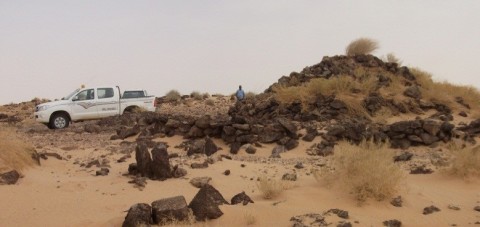Not far from our Tasiast gold mine are rich finds of another kind; buried cultural treasures, including stone tools and tombs dating as far back as 9,000 ago that our Tasiast team is helping to preserve and protect.
To the untrained eye, the archeological sites scattered amongst the stubby shrubs and dunes of the Mauritanian desert are hard to identify, but they are testaments to a once well-inhabited region. Archeologists suspect the Sahel was once lush and green before desertification crept across the land about 4,000 years, pushing human settlement out with it.
The former inhabitants however, left behind a rich trove for archaeologists to study and document. Some of the sites that have been discovered include Neolithic occupation and burial sites, thought to be approximately 2,800 – 9,000 years old. Among the found artifacts are stone tools (projectile points, knives, awls, scrapers, polished axes and waste flakes), milling stones for grinding or crushing food, broken pottery, some of it decorated, and fragments of eroded, bleached-white animal and human bones.
As part of our commitment to protect Mauritania’s archaeological heritage, members of our Tasiast team recently took part in a workshop on archaeological sites protection organized by the Mauritanian Institute for Scientific Research (IMRS) in the capital city of Nouakchott.
“These finds are integral to the social and cultural fabric of Mauritania. It’s very rewarding to play a part in their discovery and preservation through our partnership with IMRS,” said Environmental Manger André Pieters at the workshop’s launch.
Tasiast management has put in place a number of measures to minimize any potential impact of mining operations on these archaeological sites. Among these is the Chance Find Procedure which stipulates that upon discovery of actual or suspected archaeological remains, work should be stopped, the site protected and the remains reported and documented. All sites of potential interest are fenced in.

Clustered on rocky ridges are Protohistoric tombs dating from 2,500 BP – 1,000 AD, generally 2 to 10 metres wide and 0.5 to 2 metres high

Variations of these tombs include crescent-shaped ‘antenna’ tombs, large tombs with kerbstones and standing stones, some of which may date from the Neolithic period

A close-up of a tomb

André Pieters, Environment Manager, Tasiast, at the IMRS workshop



